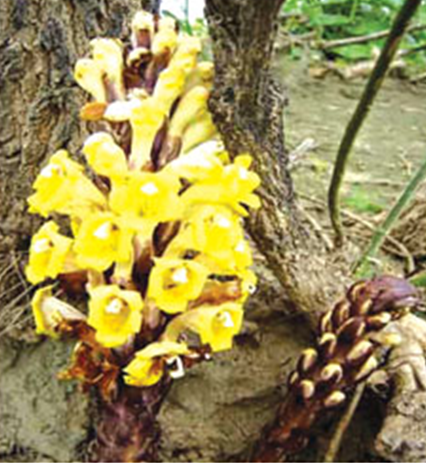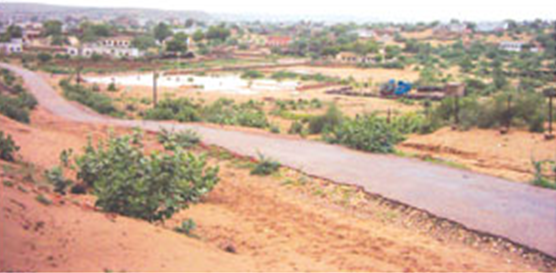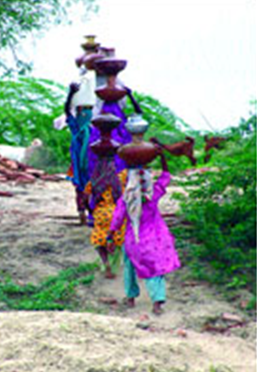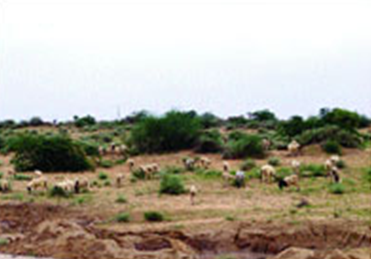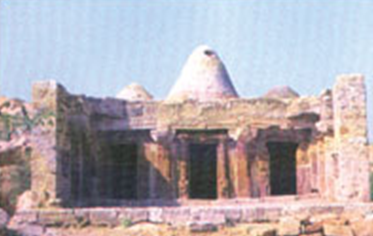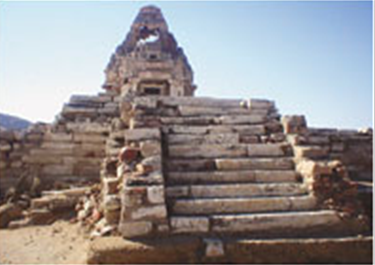Thar
This is a collection of articles archived for the excellence of their content. Readers will be able to edit existing articles and post new articles directly |
Contents |
Thar goes green
By Imdad Soomro
There’s no better sight than seeing a desert turn into a blooming garden
These days, Thar appears to be a figment of someone’s fertile imagination. The entire desert is covered in lush green grass, numerous vegetables and flowers. The Terai, a water reservoir in Thar, is the sole source for animals and birds to quench their thirst. So many Terais are now filled with water and have virtually been turned into lakes.
It has been raining in the region for the last two months. It started in June and is still continuing. “I’ve never witnessed such rains in my 40-year life,” says Anwar, a hotel owner in Nangarparker. The Tharies say the wet spell has come after 25 years. There used to be considerable rains in the past, but not like what they’ve been witnessing lately.
This scribe saw children enjoying themselves in the rain, something that’s not generally witnessed during monsoon. It’s time rejoice in Thar. One may feel surprised while crossing Kajal Sar Terai near Nagarparkar. It is unbelievable. It looks like the Keenjhar Lake. Kjla Sar Terai has a fascinating myth associated with it: beautiful girls in Parkar used to wash their eyes in the Terai. No different is the Sangah Terai near the Weera Wah check post.
There are 12 rivers in the region that flow from the Karonjhar Mountain. The main rivers are Gordharo and Bhatyani. Regional poets have sung praises for these rivers in their poetry. A folksinger, Abdullah Mangrio, is from Nagarparkar. He sings for visitors who come to see Karonjhar. He sings a rasoro (a kind of verse in the Parkari language), “Dougar witch mein sardharo dhamse/jehn mein nit nit sadhora navey/amen pardesi wala prem na pyase.” It means, in this mountain the Sardharo River is widely praised, the great sadhus come to bathe here … but we are thirsty for love. In Nagarparkar, the Parkari language is spoken by the majority of its people, both Muslim and Hindus. One finds exemplary religious harmony in the region.
Those who’re bothered by the rains in Karachi come to Thar in big numbers, and to their surprise they see life in an entirely different light.
However, the one disappointing thing for tourists in Nagarparkar and other main towns in Thar is that there are no hotels, restaurants or lodges for them to stay at and enjoy the season. The tourism department has virtually done nothing to provide relevant facilities to tourists. There aren’t even roads that can comfortably lead the visitors to Thar. According a survey, a 1,200-km road was constructed in the past. “Not for us, but because of the coal that is found in Thar,” says a local man. This has made reaching Nagarparkar a terribly long journey.
Bharo Mal Amrani, an environmentalist and poet, has a different tale to tell. “Thar is in the earthquake zone, that’s why chaunra — earthquake-proof houses — can be seen here,” he says.
According Bharo, the traditions and living conditions in the region did not used to be man-friendly. They were more suited to animals. Not anymore. Vegetables and crops here are pest-free. But the Tharies don’t take advantage of this fact.
A local singer, Abdullah Mangrio, singing floks songs in Parkari says, “Mara mithra mehman bhal aeen.” It means my sweet guest, welcome to my homeland. Near him a young Parkari boy plays a folk tune on the bansuri. They play and sing for visitors who would give them money for singing songs. A guide too happens to be around here.
These things seem to be happening for the first time in Nagarparkar. An old man, Nawaz Ali Khoso, tells this scribe about the geography and traditions of Parkar. The area was introduced by Javede Jabbar to the local media, he says.
In Nagarparkar, a centuries-old Jain temple still exists in the heart of the town. Some of its statues were stolen in the past by someone. Also, an old mosque of Bhodesar still exists in a poor condition.
Bhalwa, the legendary Marui’s village, has a typical Thari-hamlet look. When returning from Nagarparkar at night this scribe saw some beautiful horses along the road near Bhalwa without any riders.
The well from where Marui was kidnapped by Prince Umar Soomro of Umarkot is still there, and visitors come here to have a look at it. In the times of the Soomra dynasty Marui had rejected all things offered by Umar and remained firm in her stand.
Thar, considered an arid zone, covers an area of 24,000 square miles. It is divided into different parts. Malir is a part of it. Then there is Parkar. The nomadic tribes reside in Nagarparkar. Rebari is a tribe that lives in the remote areas of Nagarparkar. They wear traditional black clothes. Kolhi is a big nomadic tribe as well.
Dhatt covers the land from Mithi to Chachro. It appears to be greener than all the areas. The entire landscape is now verdant and breathtaking. Thar these days is a treat to look at.
In the morning this scribe went to Rana Sar with his host. Rana Sar is a reservoir some 2kms away from Chelhar, which is known to be as the town of Charan singers. Here there is a place which is believed to be the spot where the ‘sati’ tradition used to be practised in the old days. It is so beautiful that one would forget one’s in a desert.
Unfortunately, the forest department has reserved thousands of acre’s land, saying it belongs to the department. Local residents claim that the department’s officials sell crops that grow naturally in rainwater.
As this scribe returns from the beautiful land, a folksong reverberates in mind: “The rains have come back. My eyes look for you. Come to me my beloved.”
Thar II Rainfall in a parched land
Text and photographs by Nasir Ali Panhwar
After three years of a devastating dry spell, Thar has received a substantial amount of rainfall this year. Prior to the monsoon season, the desert faced drought-like conditions which had forced people to migrate to the barrage areas along with their livestock. After the rains the people have returned to Thar.
Thar is quite fertile and has diverse flora and fauna. The green look which the desert wears after the monsoon is no different from that of the northern valleys. The brown sand dunes have turned lush green, which are not only pleasant to look at, they also stabilise the sand dunes to prevent further erosion.
After the rains a high turnover of tourists has been recorded in the area, but the town lacks basic facilities for tourists. Javed Jabbar, global vice president of the World Conservation Union, which has been working in the area for social development for the last 21 years, says there is an immense potential for tourism in Thar, but he cautions, “It should be ensured that ecology and nature are not disturbed by the promotion of tourism.”
The rains have benefited the ecology of Thar as vegetation is thriving with a wide range of plants and trees; a wide variety of birds can also be seen in abundance. The District Government, Tharparkar, has passed several resolutions to conserve peacocks and indigenous trees in Thar.
Rainwater has been stored in traditional water ponds called tarais and household tankas. This will also contribute significantly in raising the subsoil water level.
The monsoon period starts from June every year and goes on till September. Rainfall in the region is quite erratic, which keeps Tharis on tenterhooks, as their livelihood is highly dependent on rains. From June to September four rainfalls, with the interval of 20 days, are essential for achieving better agricultural yields.
For a long time agricultural practices in the area were limited to traditional methods. However, the recent years have seen mechanisation of agriculture in the region, which will have far reaching consequences on the ecology of Thar. The use of tractor for cultivation for consecutive years has negative effects on the production capacity of the soil. The blade of the tractor plough goes deep into the sandy soil destroying useful vegetation.
Tharis are known as one of the most environment friendly people, as they live close to nature and not only value it but conserve it conscientiously. They make wise use of the resources, as they know that if it does not rain their lives would become miserable. They do not waste water and ensure that every single drop is used judiciously.
Thar is called the land of beauty and mystery, where poverty and resources exist together. However, with the discovery of huge coal reserves under the sand dunes of Thar, one anticipates a brighter future for the Tharis.
Thar III Architectural beauties
By Ihsan H. Nadiem
The Thar region has a brilliant architectural past that not many admirers of the land know about
THE Thar, even if it is known as ‘land of death’ — marus-desa, marusthali or in its corrupted form simply as Thar — is not that devoid of architectural treasures which make the region culturally rich and a pride for its inhabitants. The presence of many a historic structure also clearly points towards it having been a flourishing region at some point of history. The now lost river Hakra and several other dry courses of water sources (nadi) must have supported a much larger population even in remote antiquity. In the light of archaeological surveys carried out elsewhere in the contiguous desert areas of Pakistan, it can safely be deduced that the Thar might have also been a scene of cultural activity in the remote past. Although no remains of the primeval presence of artefacts have yet been discovered in the whole of this Pakistani desert, if Cholistan could be any indicator, there is strong possibility of finding the Chalcolithic, or even Palaeolithic, period here in case it is subjected to scientific exploration.
The built heritage standing above ground in the Thar and Parkar region, strangely enough, consists only of either religious or military architecture. There are no palatial buildings or royal-residences to be found independently or in its forts otherwise known to be residential-ones. The population seems to have lived in thatched huts known as chownra — built of perishable material — put up singly or as a part of ensemble that goes to make a Thari village. The only buildings in these villages constructed in sun-dried or baked bricks are the ones known as autak used as community guest house or the male-portion of some ‘wadera’ whose residence could also be in the same material even if situated away from it.
The embellishment on the buildings belonging to the religious genre does suggest perfection in this art but hardly throws any light on the life of the people of a particular era. Some remains of towns or ports found towards its southern side may, however, back-up the theory of its having better populated and enjoying greater prosperity in those times.
The religious architecture of the Thar and Parkar region is represented by a mosque and some Jain temples situated at different places, scattered mostly over southern Thar. In addition to an ensemble of such religious monuments in the vicinity of Nangarparkar, some of the other outstanding pieces of architectural history of the region are as under:
Jain Temple at Viravah: Viravah, about 24kms north of Nangarparkar town, stands close to the ruined remains of Pari-Nangar which is thought to be an ancient port destroyed either by the troops of the Delhi emperor in 1226AC, or by an earthquake. Viravah itself appears to have been built over part of Pari-Nangar. A small singly standing temple still survives at the place. It is wholly built in white marble and consists of an open group of pillars with carved capitals.
The remains of the buildings, of which this single structure could have been a part, are still visible in the neighbourhood. A number of marble pieces, in the shape of chiselled and dressed blocks, lie scattered although much of the material has already been re-used in other buildings of the modern era. Among these ruins of foundations was found a beautifully carved block of marble 2m x 0.87m. This stone is now displayed in the National Museum of Pakistan at Karachi. A few other carved marble stone blocks also adorn the officers’ mess of the Pakistan Rangers situated near the site.
Jain temple at Gorri: At Gorri, deep in the desert about 22kms northwest of Viravah, some 4kms from Marui jo Magh Malir — the famous hometown of the heroine of the legendary love-story, Umer Marvi — lies an old Jain temple. It consists of an open hall called mandap with an intermediate chamber known as Arthimandapa, connected with cells. Although such elements are also found in the Jain temples elsewhere in the Thar yet here they are singularly superior in craftsmanship and finish. Though no inscription to the effect of its origin has been found from here, it is said that it was built in the heyday of the Sodhas around 1370AC.
The temple is located within an enclosure with an open space in front on the northern side. It is constructed with Jodhpuri stone much like marble. The main building is 27.6m in length and 18.5m in width. A chhatri-like domed extension with free-standing columns covers the front door of the main building. The interior of its top is decorated with painted figures of men and women. There are two rows of cells, six each on east and west, while entering towards south from the door. These cells also carry domes at the top.
By the side of the front door there appears an opening leading to the basement, which could not be accessed due to closure for a very long period of time. It is said that sometime during the first quarter of the 18th century, H.C.Watson, the then Deputy Commissioner of Thar and Parkar districts, had made an attempt to dig it out but under the influence of superstitions had to abandon almost right at the start.
It is recorded to have been much defaced at various times by Sindhi troops. ‘It is said to have suffered from fire, and from gunpowder which was used by Colonel Trywhitt, at the time of Nangar outbreak, in order to secure a Sodha chief who was supposed to be hiding himself in its passage.’ The last major repairs are recorded to have been carried out in 1715AC, though some of the much-dilapidated cells were provided prop-up pillars in brick and portland cement during the 1980s.
The followers of Jain religion are the worshippers of Parasnath, also known as Gorrejo hence the name Gorri. S. N. Raikes in his Memoir on the Thurr and Parkar published from Bombay in 1856AC, has an interesting story to tell about the idol of Parasnath, which belonged to this temple. “The Soda Chiefs of Veerawow are said to have taken the idol called Goreeha out of the temple for safe custody, and to have exhibited it occasionally to the Banians, who worshipped it, for payment. The present chief’s grandfather was the last who thus exhibited it, and who accumulated a large sum by the exhibition. He, however, kept its hiding-place a secret, and subsequently, dying rather unexpectedly, omitted to communicate to his heirs and successors where the cherished idol was deposited; nor has it been found to this day, much to the chagrin of both Chiefs and Banians — to the former, as its possession was a source of no inconsiderable revenue periodically; and to the latter, from superstitious apprehensions of the deity’s wrath being excited, by apparent though unintentional neglect.”
However, the neglect of these gems of historic architecture seems to be a universal phenomenon in Pakistan as most of these are only left at the mercy of the petty chowkidars or, at the best, nature’s goodwill. The authorities supposed to look after these pearls of the past hardly even visit them to see their plight. Its time someone in authority woke up to their needs and did something before it became too late to save these witnesses of history from complete annihilation, left to be found only in official records or some history books.
This article has been extracted from THE IMPERIAL GAZETTEER OF INDIA , 1908. OXFORD, AT THE CLARENDON PRESS. |
Note: National, provincial and district boundaries have changed considerably since 1908. Typically, old states, ‘divisions’ and districts have been broken into smaller units, and many tahsils upgraded to districts. Some units have since been renamed. Therefore, this article is being posted mainly for its historical value.
Thar
Subdivision of Thar and Parkar District, Sind, Bombay, composed of the Mithi, Diplo, Chachro, and Nagar talukas.
